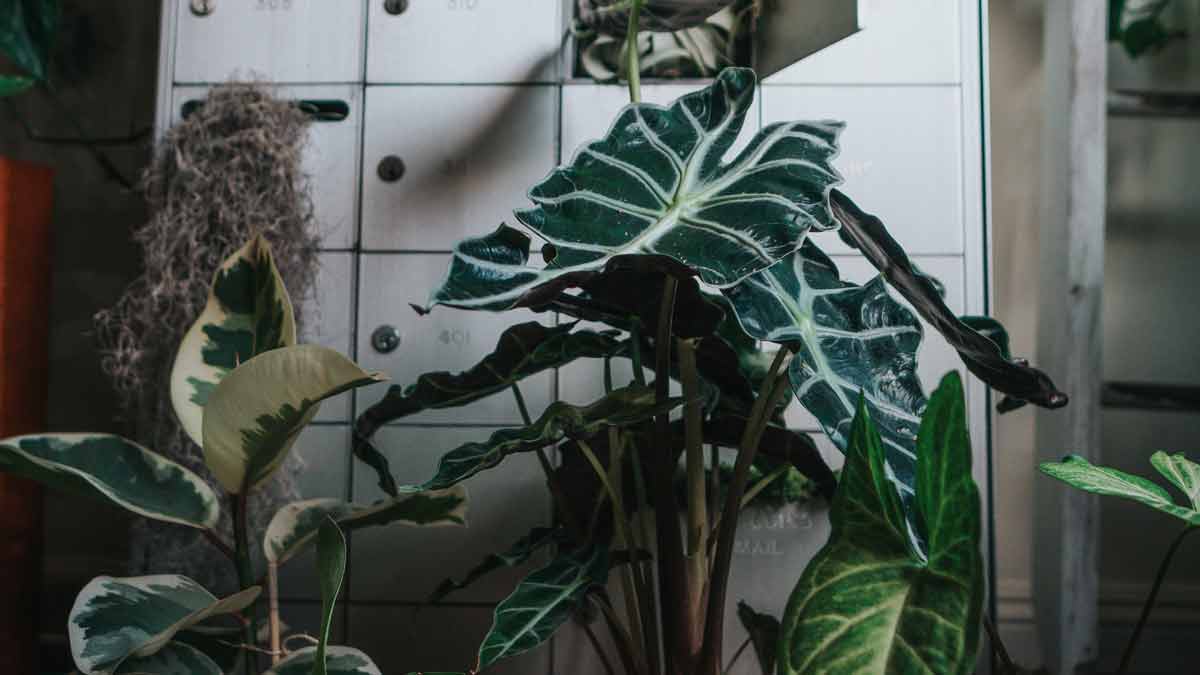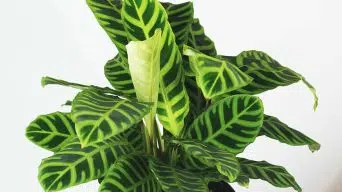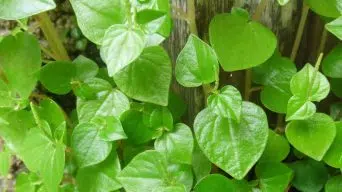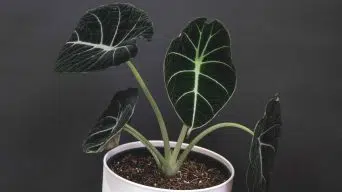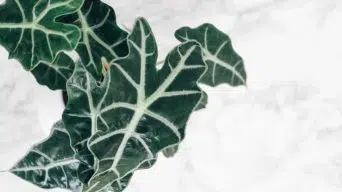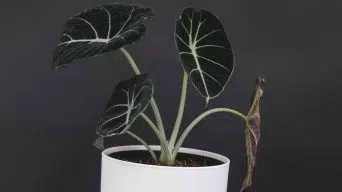To prune an Alocasia plant, cut dead stems and yellow or brown leaves as close to the base as possible using sharp pruning shears. It’s best to do this in the spring or summer when the plant is actively growing. Use sterile, sharp pruning shears or scissors.
Alocasia plants, also known as elephant ears or African mask plants, are stunning tropical beauties that bring an exotic flair to any indoor space.
However, keeping these elegant houseplants healthy and vibrant requires proper care and attention, particularly concerning pruning.
This guide will explore the importance of pruning your Alocasia plant in promoting its growth and overall health while maintaining its desired shape and size.
Reasons For Pruning Alocasia Plants
Pruning is a fundamental aspect of plant care that is critical in enhancing plants’ health, vigor, and overall appearance.
Alocasia plants, with their unique and striking foliage, are no exception.
Regular pruning of Alocasia plants is necessary to promote optimal growth, ensure longevity, and maintain their desired shape and size.
By removing dead or diseased foliage, trimming back overgrown stems, and encouraging new growth, pruning helps to keep Alocasia plants thriving and looking their best.
Promotes Plant Health
Pruning your Alocasia plant is essential for maintaining its overall health and ensuring that it thrives.
Trimming away damaged, dying, or dead foliage allows the plant to redirect its energy and nutrients toward promoting the growth of robust leaves and stems.
For example, if an Alocasia owner notices yellowing leaves on their African Mask Plant or spider mites infesting the glossy foliage of their Black Velvet variety, proper pruning can help control these issues by removing affected areas.
Not only does this prevent the further spread of illnesses or pests throughout the plant, but it also encourages new leaf growth in optimal conditions.
Encourages Growth
Pruning your Alocasia plant helps maintain its desired shape and size and plays a crucial role in stimulating vigorous growth.
Removing dead, damaged, or crowded leaves allows the plant to focus its energy on producing new foliage and maintaining healthy existing leaves.
For instance, proper pruning can promote the growth of large leaves with vibrant patterns when growing an Alocasia Polly or an Alocasia Black Velvet indoors.
Moreover, you’ll foster a bushier appearance for your tropical houseplant by encouraging branching through strategic cuts just above leaf nodes during the growing season (usually spring or summer).
Maintains Desired Shape And Size
Pruning your Alocasia plant not only promotes its health but also ensures that it maintains the desired shape and size.
As a tropical plant, Alocasia can grow quite large, often taking up valuable space in your indoor garden or becoming unruly if left unchecked.
For example, if your goal is to have a more compact elephant ear plant with lush foliage closer to the base instead of towering leaves, selectively prune and remove some of the larger leaf stalks higher up on the plant.
This will encourage new growth at lower points while maintaining an appealing look for any interior setting.
Remember that proper pruning techniques are essential when shaping your Alocasia. Clean cuts made with sharp tools help prevent damage to healthy tissue and reduce stress on the plant during this process.
Understanding When To Prune Alocasia Plants
Proper pruning can make all the difference in the health and appearance of your Alocasia plant.
However, timing is vital, and understanding when to prune is crucial for optimal results.
Signs That Indicate It’s Time To Prune
If you’re wondering when to prune your Alocasia plant, several signs indicate it’s time to get out the pruning shears.
Here are some things to look out for:
- Yellow, brown, or damaged leaves: The most obvious sign that it’s time to prune your Alocasia plant is when it has yellow, brown, or damaged leaves. These leaves can be a sign of disease, pest infestation, or natural aging.
- Overcrowding: If your Alocasia plant grows too large for its pot or space, it may be time to prune back some of the foliage. Overcrowding can lead to poor growth and unhealthy plants.
- Leggy stems: Leggy stems with few leaves can indicate that your Alocasia plant needs pruning. Pruning these stems will encourage new growth and promote a fuller appearance.
- Uneven growth: If your Alocasia plant is growing unevenly, with some areas growing faster than others, it may be time to prune back the faster-growing sections to encourage more balanced growth.
Remember, there’s no need to prune your Alocasia plant unless you notice these signs or want to maintain a specific size or shape.
Always use sterile pruning tools and do not remove too much foliage at once, which can stress the plant and lead to further damage.
The Best Time To Prune Alocasia Plants
Alocasia plants require pruning to remove dead, yellow, or damaged leaves and promote new foliage growth.
For best results, it’s recommended to prune Alocasia plants in the spring when new growth starts appearing.
During this time, Alocasia plants experience an active growing season that allows them to heal wounds quickly and grow back stronger.
It is important to avoid pruning during winter as it can stress the plant and delay recovery time.
Weather conditions, soil moisture levels, and light exposure should be considered before pruning your Alocasia plant.
Factors To Consider Before Pruning
Before pruning your Alocasia plant, there are some factors to consider that will ensure a successful and healthy outcome.
Here are some things to keep in mind:
- Assess the plant’s health: It’s vital to ensure your Alocasia plant is healthy before pruning it. Check for any signs of disease or pest infestation, which could affect the regrowth process.
- Determine the purpose of pruning: Decide why you’re pruning your Alocasia plant – is it to remove damaged leaves, promote growth, or maintain its shape? This will help you decide which areas of the plant to prune.
- Choose the right tools: Use sharp and clean pruning shears or scissors to make clean cuts that won’t damage the plant. Avoid using blunt or dirty tools, as they can introduce infections that could harm your Alocasia plant.
- Timing matters: Make sure you prune at the right time – when new shoots are starting to emerge in spring or early summer. Avoid pruning during fall or winter, as it might slow the regrowth process.
- Plan ahead: Visualize how you want your Alocasia plant to look after you’ve pruned it, and plan accordingly. Don’t remove more than ⅓ of the leaves at a time, as this could shock the plant and affect its growth.
A Complete Step-by-Step Guide For Properly Pruning Your Alocasia Plant
Proper pruning is crucial to maintaining a healthy and thriving Alocasia plant.
Armed with clean and sharp pruning shears, identifying and removing any dead or improperly growing leaves and stems is a simple yet essential task.
With a delicate touch and a keen eye, carefully snipping as close to the base as possible without harming surrounding healthy foliage is the key to encouraging your Alocasia to flourish.
Tools Required For Pruning
To correctly prune your Alocasia plant, you will need the following tools:
- Pruning shears: Use a clean and sharp pair of pruning shears to make precise cuts without damaging the surrounding foliage.
- Rubbing alcohol: Clean the blades of your pruning shears with rubbing alcohol before and after each use to prevent the spread of diseases.
- Gloves: Wear protective gloves to avoid getting cut by sharp leaves or irritated by sap from the plant.
- Paper towels: Use paper towels to clean the pruning shears between cuts and wipe off any excess sap or moisture.
- Trash bag: Keep a trash bag handy to dispose of any dead or diseased parts of the plant that you remove during pruning.
Remember, having the right tools is essential for successfully pruning your Alocasia plant and maintaining its health and beauty.
Identifying Areas For Pruning
Before you start pruning your Alocasia plant, it’s critical to identify the areas that need to be trimmed.
Here are the steps you should follow:
- Look for dead or yellowing leaves: Prune these leaves at their base. Removing the dead foliage helps prevent pests and diseases and ensures that your plant allocates resources where needed most.
- Trim off damaged stems: Cut off any broken or unhealthy stems. This will encourage new growth and prevent the spread of disease.
- Cut back overgrown portions: If any parts of your Alocasia are becoming too large or out of shape, cut them back to maintain a balanced appearance.
- Remove suckers or offsets: Some Alocasia plants produce “suckers,” which are small offshoots from the main plant. If desired, these can be pruned off with sharp, clean scissors and propagated into new plants.
Remember to treat each wound with antifungal powder to prevent infection!
Making The Cut
When cutting your Alocasia plant, using sharp and sterilized pruning shears or knives is essential.
This helps to prevent unnecessary damage and disease from spreading throughout the plant.
Start by identifying which leaves or stems need to be pruned, then make a clean cut at the base of the stem with a 45-degree angle.
It’s also essential to be mindful of where you are making cuts on your Alocasia plant.
Cutting off healthy leaves may stunt their growth, while removing dead or dying ones can encourage new leaf growth.
Always assess each leaf before making any cuts and consider whether it’s adding value to your plant’s overall health and appearance.
Treating The Wound
After pruning your Alocasia plant, treating the wound is important to prevent potential infections or diseases.
First, use clean utensils or shears to make a clean cut on the plant stem.
Next, apply some cinnamon powder onto the cut area as a natural fungicide and anti-bacterial agent.
Additionally, watch your plant the following days after pruning for any signs of distress or further damage.
With proper care and attention, your pruned Alocasia plant should recover quickly and thrive in its new shape and size.
Aftercare For Pruned Alocasia Plants
In gardening, pruning is an essential process that helps keep your plants healthy and attractive.
However, proper aftercare is essential to ensure their continued growth and vitality.
This is especially true for Alocasia plants requiring specific care after pruning to thrive.
In this section, we’ll explore the crucial steps involved in the aftercare of your Alocasia plant, including watering, fertilizing, and providing adequate light.
Following these essential guidelines can help ensure your plant continues flourishing long after pruning.
Watering
Consistent moisture is crucial for Alocasia plants, but they can tolerate some dryness between waterings.
Overwatering or underwatering can cause yellow leaves in African Mask Plants, which should be cut off immediately to prevent further damage.
When watering your plant, ensure the soil is evenly moist but not soggy.
Water thoroughly and allow excess water to drain out from the bottom of the pot.
It’s important to note that Alocasia plants require more frequent watering during their growing season than in winter when they go dormant.
In addition, humidity levels play a vital role in keeping these tropical plants happy and healthy.
Boost humidity by misting the leaves regularly or placing a saucer filled with pebbles and water underneath the pot.
Fertilizing
Proper fertilization is essential for the growth and health of Alocasia plants.
As mentioned earlier, feeding your Alocasia plant with a balanced liquid fertilizer is recommended once a month.
For instance, if you own an Alocasia Jacklyn or Maharani, regular feeding with a balanced liquid fertilizer is crucial in promoting their growth and overall health.
Therefore, as an Alocasia owner, it’s vital to understand that proper fertilization plays a significant role in ensuring the wellness of your beloved plant species.
Providing Adequate Light
Providing adequate light is one of the most critical factors in aftercare for pruned Alocasia plants.
These tropical plants require bright, indirect light to thrive, but direct sunlight can scorch their leaves.
If you don’t have access to sufficient natural light, consider supplementing with artificial grow lights specifically designed for indoor plants.
Remember that too much or too little light may lead to stunted growth, yellowed leaves, or even death.
Final Thoughts
Pruning your Alocasia plant is essential to keep it healthy, promote growth and maintain the desired shape and size.
You can ensure your plant will thrive by using clean and sharp tools, identifying areas that need pruning, making a clean cut, and treating the wound afterward.
Remember to provide adequate care, such as watering regularly, fertilizing, and providing enough indirect light for your Alocasia plants to stay vibrant.
With proper pruning techniques, you can prevent diseases from spreading while also increasing their lifespan.

